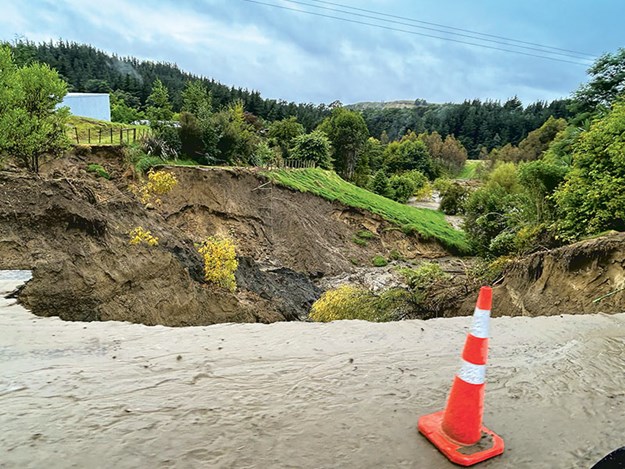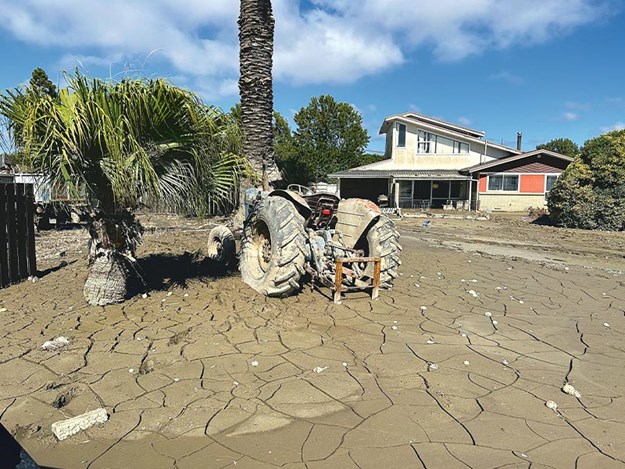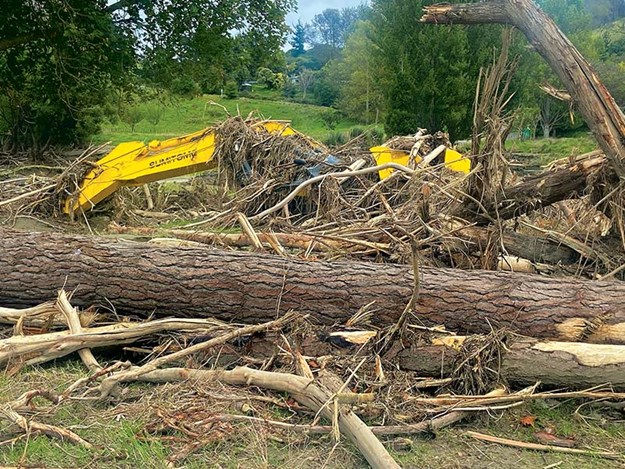Special feature: Cyclone Gabrielle
Well-known heavy equipment rep Phil Means gives an insight into the cyclone that wreaked havoc across many parts of the North Island recently and his experience in the Hawke’s Bay
15 February 2023
Watching the Cyclone Gabrielle news unfold online at our hotel in Hobart, my wife and I are desperately trying to find out if our family are safe and well. Cellphone towers back home aren’t working; power is out and any form of communication is a nightmare. To top it off, Air Zealand cancels our flight to Napier, leaving us unsure as to when we can get home.

18 February 2023

With flights home finally sorted, on a beautiful clear day we fly into Napier. As the plane banks over the hills from the south, we can’t believe what we were seeing. From Taupō onwards, it looks like a giant had taken his huge mitts and clawed at the landscape. In Hawke’s Bay. bridges are destroyed, rivers flooded and much of the land is under water. My wife, who was brought up in Puketitiri, sobs as we look at the devastation from the air.
Arriving home, we catch up with family and friends and listen to tales of survival and heartache.
We find out that all our family are safe and alive but nine are homeless from water that has ravaged their homes, land, and livelihoods. Fortunately, our home is undamaged and instead of just my wife and me, we will now house six family members, two large dogs and a cat.
Sharing accommodation is common throughout the region, as family members and friends bunk in with others. Many of the homeless are accommodated in maraes, churches, and other temporary housing, with many not sure if they can rebuild or where they are going to live.
19 February–20 February 2023

Where to start? Firstly, in response to the devastation, I apply for leave from work and pitch in with the clean-up. I start at my mother-in-law’s property, joining her youngest son from Queenstown, trying to make progress in the mud. The priority is cleaning silt and mud from the damaged buildings and attempting to salvage personal belongings.
The Central Stags Cricket team show up, this being the third family property they have helped clear in as many days. These great young men are volunteering their time and make short work of the clean-up supervised by my brother-in-law, whose experience as a builder and project manager simplify what is a huge task.
21 February–7 March 2023

I am very aware of further damage in the area and offer my services to earthmoving contractors in the region needing some help. A local earthmoving company ask if I can drive a tractor for them, so I start five days of work that consists of 5.30am starts and 5.30pm finishes. They are working on Ohurakura Road, Te Pōhue, with a goal of securing it so Defence Force personnel can access the Napier-Wairoa Road at Tutira.
What a great team of guys I am working with. They are putting in long hours starting in the dark and finishing late at night. I’m impressed at the true professionalism, courtesy, and compassion shown to the locals, some of who have lost much. Many people have lost a lot more.
There are many local contractors going above and beyond, ordinary fellows not wanting to be mentioned here, but the true stuff of heroes. I speak to one contractor who wishes to remain nameless. On the morning of 16 February, he flew four of his operators up to Whittle Road, Patoka Puketitiri, where they had left their excavators and loaders. They started clearing roads, rebuilding culverts, and reinstating water tables. These unnamed legends worked for three days in horrendous conditions. They made their way to Rissington Bridge and cleared approximately 30km of road, creating access for the local community.
The boss of the company I’m helping out believes property and land in Dartmoor has suffered more damage than Esk Valley. He says, if the stopbank had breached further up the river, Taradale (a suburb with a population of about 14,000 people) would have experienced extreme flooding. The bulk of the water travelled to Pakowhai, resulting in significant damage to property there and loss of livestock and livelihoods.
As a result of the floods, many contractors have put prior work on hold, with a ‘get in and get it done’ attitude.
Some contractors I speak with are of the opinion that one of the contributing factors to the devastating flood waters was overgrown vegetation on the riverbanks causing blockages when the sheer volume of water tore the vegetation from the banks. Unfortunately, Hawke’s Bay was already very, very wet from many months previously of unrelenting rain.
Another says they believe the flooding was caused by the sodden land, willows, and native trees slipping off already-soaked hillsides stripping land down to the papa rock.
.jpg)
Many hours of gruelling work result in tired people, not only by the physical labour but also from seeing the devastation, that for so many, is taking its toll. I’m not comfortable taking photos, until being asked to write this article. It didn’t seem the right thing to do, as I continually drive through areas in sadness, looking at the ruin and devastation.
One team I speak doing a variety of work and the one job that is impressive is the helicopter pilots bringing in power poles for Unison. ‘Bloody legends’ is the term being used. They supply the holes and the pilots put the poles in gently as you please.
In Puketitiri, I speak to a local logging and firewood contractor who also wishes to remain anonymous. He has lost his home, business, and ability to work. All he could do was look at a high and wide 30-tonne log loader in his yard, which has been completely submerged. Incredibly, the silt is five metres up his barn wall and apples from neighbouring orchards sit in the rafters. He points out that there will be about 1200 cord of wood unavailable to local households this winter, showing yet another example of how the floods will continue to affect many.
He says it may not be until sometime in April or possibly later before roads are in a condition for trucks to get in and move stock for farmers and logging to resume. As we sit talking, he also mentions how the disaster has affected education. The children in Patoka and Puketitiri and other isolated areas are having to attend boarding schools, as they can’t get home yet.
My summary

The contractors I speak with are modest and humble. They are good at what they do and are not looking for admiration, however, the consistent message is that the work should be left to those who know how to do it.
What is critical are the relationships with locals and contractors who have local knowledge, know the land, and how to use the available materials to best get road access repaired and open.
As I contemplate the complications that now surround the aftermath of Cyclone Gabrielle, I am proud of the capable professional contractors, men and women helping rebuild Hawke’s Bay. What I do know is that there is no quick fix. The work required to bring the region back to some sense of normality is overwhelming for everyone, but from what I have seen, the public have some excellent contractors on their side.
Keep up to date in the industry by signing up to Deals on Wheels' free newsletter or liking us on Facebook.

.jpg)
.gif)
.gif)
.gif)
.gif)

